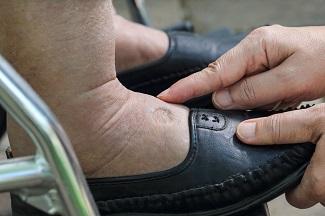Managing Lymphedema: Essential Strategies for Wound Care Providers
May 31, 2019
As health care professionals, we see patients with lymphedema every day. However, do we know how to manage lymphedema? Are we confident in successful management of lymphedema? The answer, many times, is no. The lymphatic system goes hand in hand with the integumentary and vascular systems. Certified Lymphedema Specialists play a critical role in lymphedema and wound care expertise, but providers must also learn to approach the complexity of lymphedema with or without wounds with foundational knowledge and skills to provide the best outcome. Underlying medical conditions must also be properly managed. Hospitals, wound care clinics, and private practices should develop a comprehensive lymphedema management program.
Lymphedema is classified as either primary or secondary, with secondary being the most common type. Lymphedema is swelling of any location on the body from the head to toe but is most commonly found in the extremities. The cause of lymphedema can be summed up as an abnormal accumulation of protein-rich fluid in an affected area. The origin of primary lymphedema is lymphatic dysplasia developing from birth but presenting more commonly later in life without evident cause. The origin of secondary lymphedema is cancer radiation therapy, surgery, endocrine disease, venous disease, injury, scarring, inflammation, immobility, or infection of the lymphatic system.1,2
Lymphedema Diagnosis
Diagnosing lymphedema involves a combination of the patient’s history, systems review, inspection, palpation, and a few select non-invasive tests.2 A thorough physical examination is very important because not all swelling is the result of lymphedema. Be sure to include the following in your examination:2
- Onset of symptoms
- Current and past medical history
- Family history
- Volume and girth measurements
- Checking for Stemmer’s sign. Stemmer’s sign is a thickened fold of skin at the base of the second toe or second finger that can be gently pinched and lifted. This is most often an early diagnostic indication of primary lymphedema. It can also develop later in secondary lymphedema.
- Pain assessment
- Social habits (smoking, nutritional status, physical fitness, and weight)
- Functional status and activity level
- Non-invasive tests (bioimpedance scanning , perometry, tonometry [indurometry])3
- Imaging techniques (lymphoscintigraphy, magnetic resonance lymphangiography, near-infrared fluorescence–Photodynamic Eye, ultrasonography, computed tomography)3
Lymphedema Staging System4
- Stage 0 – Latent or preclinical stage; risk of developing lymphedema; no visible evidence. Can be present for months to years before clinical presentation.
- Stage 1 – Borderline or negative Stemmer’s sign; pitting edema and visible swelling with protein-rich lymph; no palpable fibrosis. Swelling can be temporarily reduced by elevation; however, swelling returns if limb is returned to normal position.
- Stage 2 – Positive Stemmer’s sign; hyperkeratosis and papillomatosis present. Patients with increased swelling, fibrosis, infections, and further skin problems are at a higher risk.
- Stage 3 – Swelling is extreme and thickened because of blockage in the flow of lymph and buildup of protein and debris in tissues. Skin elasticity is lost, and tissues become fibrotic. The skin hangs in lobules, and skin ulcerations or scarring maybe present. This stage is also known as lymphostatic elephantiasis.
Lymphedema Management
Complete decongestive therapy (CDT) is considered the gold standard of care in managing lymphedema. There are two phases of CDT:2
- Intensive phase – trained health care provider
- Maintenance phase – patient dependent
There is an array of bandages (short stretch) and garments (elastic and inelastic) to combine in lymphedema management. Short stretch bandages are woven cotton only and support tissues safely and comfortably with a low resting pressure for long-term treatment. The distinction lies in the working and resting forces generated by bandage or garment compression. Decongestive therapy can be performed only by an experienced and/or certified therapist.4 Bandages or garments help do the following:
- Minimize the ultrafiltration rate
- Improve efficiency of muscle or joint pumps
- Prevent re-accumulation of evacuated lymph fluid
- Break up deposits of accumulated scar and connective tissue
Compression therapy can help reduce pain and swelling. Education of the patient and/or caregiver is imperative for good outcomes. Utilize trained lymphedema specialists in treatment and management of lymphedema to provide continuity of care.
Lymphedema Skin Care Mnemonic1
Lifestyle changes lessen risk of starting or worsening lymphedema.
Yield extreme temperatures of cold or heat.
Moisturize skin with only low-pH lotions.
Protect skin. Cleanse frequently with soap and water. Heavy lifting and joint overrotation are to be avoided.
Exercise as tolerated.
Do not travel by air without seeking advice of a lymphedema specialist.
Eat a healthy diet.
Monitor skin regularly for dryness, cracking, and signs or symptoms of infection.
Avoid exposure to animal scratches, bites, and stings.
Conclusion
There is no cure for lymphedema. However, management of lymphedema to increase quality of life is possible. The earlier the diagnosis, and the sooner treatment is implemented, the better the outcome will be.
References
1. Norton School of Lymphatic Therapy. https://www.nortonschool.com/lymphedemacourse.html. Accessed May 19, 2019.
2. Hettrick H, Aviles F Jr. Tearing down the silos of lymphedema care in the wound clinic. Today’s Wound Clinic. 2017;11(10).https://www.todayswoundclinic.com/articles/tearing-down-silos-lymphedem…. Accessed May 19, 2019.
3. Kayıran O, De la Cruz C, Tane K, Soran A. Lymphedema: from diagnosis to treatment. Turk J Surg. 2017;33(2): 51–57.
The views and opinions expressed in this blog are solely those of the author, and do not represent the views of WoundSource, HMP Global, its affiliates, or subsidiary companies.












Follow WoundSource
Tweets by WoundSource